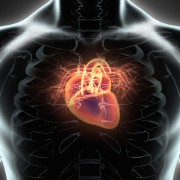Using catheter to treat coronary artery disease
Catheter-based procedures: a one-stop technique that can effectively diagnose as well as treat coronary artery disease

Coronary artery disease (CAD) is one of the most lethal conditions worldwide, responsible for about 7.4 million deaths in 2012 - almost 15 percent of all global deaths - according to the World Health Organization (WHO).
Fortunately, the death rate from CAD has steadily been decreasing over the past decade due to more advanced diagnostic and surgical approaches like catheter-based procedures.
“Catheter-based procedures are the gold standard for diagnosing and treating CAD in one go,” said Dr Nikolas Wanahita, a cardiologist at Mount Elizabeth Novena Hospital in Singapore.
CAD may cause blockages in the arteries of the cardiac muscle due to plaque build-up - or deposits of cholesterol - which in turn lead to a heart attack. This is why it is vital to diagnose and treat the condition swiftly.
A catheter-based procedure is able to do that by quickly reaching the blockages without making any long or deep incisions.
The procedure involves inserting an intravenous plastic tube – called catheter - into the patient’s wrist or groin and guiding it all the way up to the heart.
A simple diagnosis
The procedure can be used as a diagnostic tool by injecting a dye through the catheter tube, which will flow directly into the heart’s arteries while an external X-ray camera captures its movements from different angles.
The images – taken by a coronary angiogram - will show the arteries where the dye’s flow is obstructed, thus pinning down the blockage.
“Blocked arteries will also look narrower or abnormally shaped compared to healthier ones,” explained Dr Wahanita.
This procedure can identify blockages that obstruct as low as 20 percent of an artery.
Immediate treatment
Based on the results from a coronary angiogram, patients with a blockage of more than 70 percent of an artery can be treated immediately using the same access point, from the wrist or groin, through a slightly bigger catheter.
This is possible because the catheter (tube) also acts as an access point for various surgical tools, explained Dr Wanahita.
For instance, a small balloon can be advanced through the catheter and inflated while it is inside the artery to remove the plaque and open the artery. The balloon is subsequently removed.
However, this approach, also known as angioplasty, may not be effective in the long term, thus forcing patients to undergo the same procedure several times, acknowledged Dr Wanahita.
In order to avoid relapse, a stent - a metal scaffold - is implanted after removing the balloon to keep the arteries open for a longer period of time.
This also reduces the risks of damaging some blood vessels, a complication commonly associated with the use of balloons.
Dr Wanahita added that younger patients are able to opt for dissolvable stents, which eventually turn into water and gas after a few years. Thus, this type of stent would essentially disappear or dissolve over time.
“Stents aim to restore the natural function of the artery, thereby young patients may not need a durable stent,” he explained.
On the other hand, dissolvable stents can also benefit patients who may need repeated procedures by reducing the number of foreign objects that will remain inside the body.
However, despite these benefits, catheter-based treatments may not be suitable for all circumstances.
For example, if there are extensive blockages in various arteries or if the anatomy of the blockages is not suitable for catheter-based therapy, patients may require more invasive surgical procedures, such as coronary artery bypass grafting (CABG).
“These procedures are a temporary fix,” acknowledged Dr Wanahita. “They do not stop the body from developing more plaques in the future if patients do not change their lifestyle.”
Therefore, patients may still require taking medications to control high blood pressure or abnormal levels of low-density lipoprotein (LDL) cholesterol, as well as maintain a healthier lifestyle to prevent CAD from progressing.
Dr Nikolas Wanahita is a cardiologist practising at Mount Elizabeth Novena Hospital in Singapore. He is triple board certified in internal medicine, cardiovascular medicine, and interventional cardiology by the American Board of Internal Medicine.
Gramercy Heart and Vascular Centre
38 Irrawaddy Road #05-45
Mount Elizabeth Novena Specialist Centre
Singapore 329563
Tel: (+65) 6250 2662
www.mountelizabeth.com.sg
Related Articles
Why laughter may not be the best medicine
Dr Julian K.B. Tan, an interventional cardiologist at Mount Elizabeth Hospital, explains the how strong emotions may affect the heart
Read moreWhat is a heart attack?
Dr Paul Chiam discusses the importance of seeking treatment quickly in the case of a heart attack
Read moreLatest Articles
Medical Care
Achieving Swift Recovery: Enhanced Recovery (ERAS) Direct Anterior Approach Total Hip Replacement
Consider total hip replacement with Alps Orthopaedic Centre's ERAS Direct Anterior Approach for faster recovery and reduced hospital stays. Learn about Dr. Jerry Chen's expertise in Singapore.
Read moreMedical Care
Enhanced Recovery (ERAS) Total Knee Replacement
Discover how Alps Orthopaedic Centre's Enhanced Recovery After Surgery (ERAS) approach transforms total knee replacement into a day surgery, offering faster recovery, less pain, and reduced hospital bills. Learn about Dr. Jerry Chen's expertise and schedule your appointment in Singapore.
Read moreMedical Care
Clinical Exercise Physiologist (CEP): The Emerging of Exercise is Medicine
How Exercising can be a Medicine
Read more